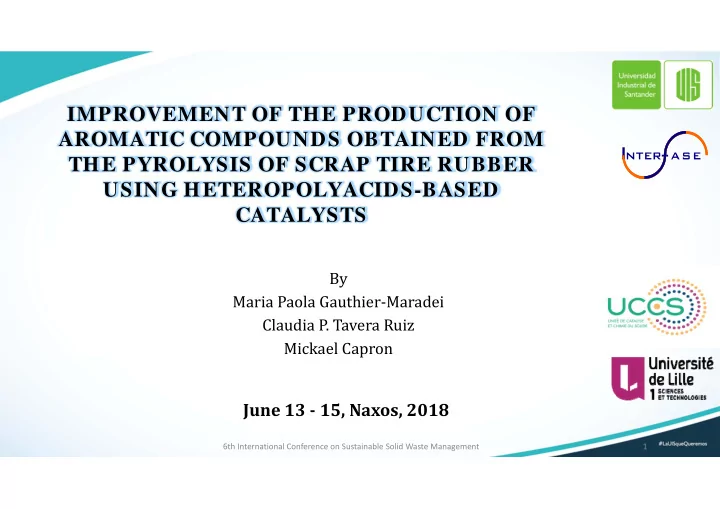

IMPROVEMENT OF THE PRODUCTION OF AROMATIC COMPOUNDS OBTAINED FROM THE PYROLYSIS OF SCRAP TIRE RUBBER USING HETEROPOLYACIDS-BASED CATALYSTS By Maria Paola Gauthier‐Maradei Claudia P. Tavera Ruiz Mickael Capron June 13 ‐ 15, Naxos, 2018 6th International Conference on Sustainable Solid Waste Management 1
Introducción D,L limonene D,L limonene BTX ar BTX aromatics omatics 30-40 wt% 30-40 wt% [3] 6-8 wt% [3] 6-8 wt% [3] [3] Benzene nzene Toluene luene N 2 Xy Xylenes Ethylbenzene Eth lbenzene Chemical synthesis of plastics, synthetic rubber, paints, pigments, explosives, PYROLYSIS pesticides, fragrances, degreasers and Mixture of aromatics, cleaning products. [4] paraffin, olefin and, sulfur Gas and nitrogen compounds in lower concentrations [2] [2] [2] M. Rofiqul Islam, H. Haniu, M. Rafiqul Alam Beg, Fuel. 87 (2008) 3112–3122. [3] [3] J.D. Martínez, M. Lapuerta, R. García-Contreras, R. Murillo, T. García, Energy and Fuels. 27 (2013) 3296–3305. [4] [4] A. Rauter, F. Brito, J. Justino, M.E. Araújo, P. dos S. Susana, Natural Products in the New Millennium: Prospects and Industrial Application, 2013. 6th International Conference on Sustainable Solid Waste Management 2
Introducción Zeolit Zeolites Bifunctional Bifunctional Pure Silica Pure Silica Lower Si/Al ratio increase in the concentration of single ring aromatic compounds Decrease of oil yield and an increase of gas yield High cracking activity
Introducción NEW ALTERNATIVE ◆ Acid and redox functions ◆ Lewis and Brønsted acidity Different reactions: ◆ Oxidation. ◆ Reduction. ◆ Condensation. ◆ Carboxylation. ◆ Dehydrogenation. ◆ Isomerization P.T. Williams, A.J. Brindle, J. Anal. Appl. Pyrolysis. 67 (2003) 143–164. M. Olazar, R. Aguado, M. Arabiourrutia, G. Lopez, A. Barona, J. Bilbao, Energy and Fuels. 22 (2008) 2909–2916. 6th International Conference on Sustainable Solid Waste Management 4
Methodology Pyrolysis of scrap tire rubber for the production of simple H 4 PMo PMo 11 11 VO VO 40 40 ring aromatics (HPMoV) D p = 0.85 - 1mm 1 H 3 PMo PMo 12 12 O 40 40 Optimization of scrap tire (HPMo) rubber pyrolysis without 20 wt% on catalyst commercial silica H 3 PW PW 12 12 O 40 40 CARiACT Q-10 2 (HPW) Pyrolysis of scrap tire rubber with catalytic stage
Methodology 1 Optimization of scrap tire rubber pyrolysis without catalyst Temperature Nitrogen volumetric Response Response (ºC) flow (ml/min at TPN) variable 1 variable 2 400 116 Aromatic Pyrolytic oil yield 466 155 compounds yield 533 223 (wt %) (wt%) 600 6th International Conference on Sustainable Solid Waste Management 6
Methodology 2 Pyrolysis of scrap tire rubber with catalytic stage Glass wool Glass wool Catalyst/tire ratio 0.2 Operating conditions 350 ºC and 155 of catalytic bed Nml/min at TPN Most favorable Operating conditions operating conditions of scrap tire bed found in stage 1 6th International Conference on Sustainable Solid Waste Management 7
Results and discussion MAXIMUM OIL YIEL MAXIMUM OIL YIELD [2] [2] M. Rofiqul Islam, H. Haniu, M. Rafiqul Alam Beg, Fuel. 87 (2008) 3112–3122. [5 [5]H. Aydin, C. Ilkiliç, Fuel. 102 (2012) 605–612. [ . [6] M. Banar, V. Akyildiz, A. Özkan, Z. Çokaygil, Ö. Onay, Energy Convers. Manag. 62 (2012) 22–30. [7 [7] C. Berrueco, E. Esperanza, F.J. Mastral, J. Ceamanos, P. García-Bacaicoa, J. Anal. Appl. Pyrolysis. 74 (2005) 245–253. [8] 8] C. Díez, M.E. Sánchez, P. Haxaire, O. Martínez, A. Morán, J. Anal. Appl. Pyrolysis. 74 (2005) 254–258. [9 [9] I. De Marco Rodriguez, M.F. Laresgoiti, M.A. Cabrero, A. Torres, M.J. Chomón, B. Caballero, Fuel Process. Technol. 72 (2001) 9–22. 6th International Conference on Sustainable Solid Waste Management 8
Results and discussion MAXIMUM AR MAXIMUM AROMA OMATIC YIEL YIELD MAXIMUM OIL YIEL MAXIMUM OIL YIELD Aromatic Oil yield Yield (wt%) (wt%) 600 ºC and 233 Nml/min 466 ºC and 155 Nml/min 6th International Conference on Sustainable Solid Waste Management 9
Results and discussion Aromatic concentration in oil with the Products yields obtained with the pyrolysis pyrolysis with and without catalytic step with and without catalytic step The oil production decreases with the catalysts Brønsted Acidity = Increase gas yield Cracking reactions
Results and discussion Concentration of the aromatics and the partially saturated cyclic compounds in the pyrolytic oil 39
Conclusions The operating variables for the pyrolysis of scrap tires having the most influence on distribution of products are the. The highest yield of pyrolysis oil does not necessarily lead to a higher yield of aromatics. The HPA based catalysts used in the catalytic reforming of volatiles from STR pyrolysis allow increasing the production of aromatic compounds but decrease the pyrolytic oil yield. The number of Brønsted sites do not promote the oil yield, founding in this study a decrease up to 41% when the Tungsten‐based catalyst was used. Therefore, the gas yield was slightly increased. 6th International Conference on Sustainable Solid Waste Management 12
Conclusions On the contrary, the aromatic concentration in pyrolytic oil was increased to close to 140% when Molybdenum‐based catalysts were used. Conversely, at these conditions, the concentration of partially saturated cyclic compounds, such as limonene, was drastically decreased. Cymenes compounds were the major aromatic compounds in pyrolytic oil as a result of the reforming of D, L limonene. The results show that the Molybdenum‐based catalysts with an high ratio of Lewis/Brønsted acid sites favors its production 6th International Conference on Sustainable Solid Waste Management 13
Paola Gauthier ‐ Maradei Associate professor Chemical Engineering School Universidad Industrial de Santander mapaomar@uis.edu.co 6th International Conference on Sustainable Solid Waste Management 14
Recommend
More recommend